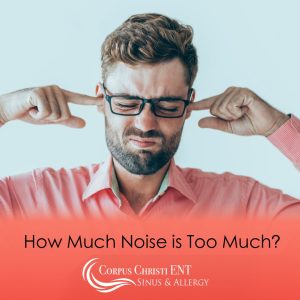
Our world today is a very noisy place. Millions of Americans are exposed to dangerously loud levels of sound on a daily basis, and most are unaware of the dangers of it. According to the American Academy of Audiology, over 30 million American workers are exposed to dangerous levels of noise on the job. But noise exposure doesn’t always happen at work. It can happen at home or when you are enjoying hobbies and other activities too.
There are two types of noise exposure: extended exposure and acoustic trauma. Extended exposure happens when people are surrounded by loud noises for several hours at a time. People who work around factories, refineries, in construction, trucking, etc. are an example of this. But also people who attend concerts, go to night clubs, monster truck rallies, car races, air shows, professional sporting events, use power tools, lawn equipment, or listen to loud music also put themselves at risk for noise induced hearing loss and tinnitus. Acoustic trauma occurs when a person is exposed to a sudden, extremely loud noise. Examples include gunshots, explosions, and bullhorns. In this case the noise is so loud, even though it is brief, it sets off a traumatic wave through the ear, damaging sensitive cells. And it only has to happen once for damage to occur.
So how much noise is too much?
OSHA, the Occupational Safety and Health Administration published noise guidelines for workers. These guidelines look at the noise level and the maximum number of safe hours to be in that environment before hearing protection is required. The noise level in the environment is measured using a sound level meter and that determines the requirement. For example, if the noise level is less than 85 decibels, then it is safe to be exposed to that level of sound for 8 hours without wearing hearing protection. But if the noise level is 85 decibels, the maximum safe time is 8 hours. If the noise level is 90 decibels, the maximum safe time is 4 hours. So, if you will be exposed to that level of noise for more than 4 hours, hearing protection is required to be worn. Any noise that exceeds 110 decibels can start to cause permanent hearing loss in as little as 2 minutes!
There are no such guidelines for recreational noise exposure. So how are you supposed to know when noises are too loud? Here are some general guidelines.
- When wearing headphones, the general rule is no more than 50% volume for 2 hours per day. If it is loud enough where someone else can hear it, not necessarily understand, but just hear it, noise induced hearing loss can start to occur in as little as 2 hours.
- If you have ever left a noisy environment, and you feel like your voice sounds muffled and there is a ringing in your ears, you have been exposed to too much noise. You most likely have experienced a temporary threshold shift and if all goes well your hearing should return to normal in a day or two, although the ringing may never go away.
The best thing to do is when in doubt, wear hearing protection; for example, ear plugs or ear muffs. There are many options available for hearing protection that are affordable and comfortable. If you are worried that you may have damaged your hearing by being exposed to noise, or are interested in finding out about what kind of custom hearing protection would be best for you, call our office for an appointment.